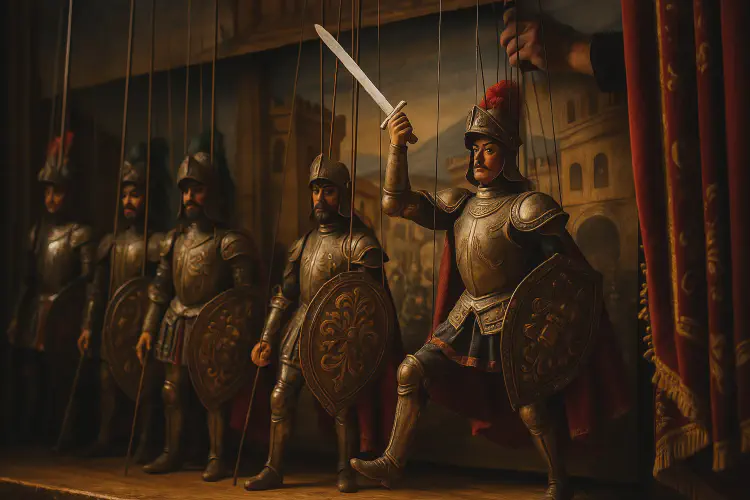Opera dei Pupi puppet theatre
The **Opera dei Pupi** is one of Sicily’s most cherished living traditions — a vibrant marionette theatre where wooden knights battle in tales of chivalry, honor, myth, and faith. Officially recognized by UNESCO, this art form carries centuries of cultural memory into the present day.
- Visit Sicily
- 3 min read

Opera dei Pupi Puppet Theatre — Sicily’s Epic Marionette Drama
🏛 Origins and UNESCO Recognition
- The Opera dei Pupi (literally “Opera of the Puppets”) emerged in the early 19th century in Sicily, drawing from chivalric narrative traditions like the Carolingian cycle and Orlando Furioso. :contentReference[oaicite:1]{index=1}
- In 2001, UNESCO proclaimed the Opera dei Pupi a Masterpiece of the Oral and Intangible Heritage of Humanity, acknowledging its cultural significance. :contentReference[oaicite:2]{index=2}
- Two main regional schools developed in Sicily — the Palermo school (western Sicily) and the Catania school (eastern Sicily). Their puppets and techniques differ in size, mechanism, and style. :contentReference[oaicite:3]{index=3}
🎭 Puppets, Puppeteers & Stories
- The puppets (pupi) are typically carved from wood, richly painted, and dressed in steel or brass armor. They represent knights, Saracens, traitors, princesses, and saints. :contentReference[oaicite:4]{index=4}
- The pupari (puppeteers) manipulate these figures from behind or above the stage, often improvising dialogue within a traditional script. :contentReference[oaicite:5]{index=5}
- Typical themes include medieval chivalry, battles between Christian and Muslim forces, betrayal, heroic quests, and sometimes more modern or local stories. :contentReference[oaicite:6]{index=6}
🔍 Differences Between Schools (Palermo vs Catania)
- Palermo school puppets tend to be lighter and more articulated; Catania school puppets are heavier and less jointed, often with fixed legs to handle weight. :contentReference[oaicite:7]{index=7}
- The performance styles also differ in movement, pacing, staging, and vocal technique. :contentReference[oaicite:8]{index=8}
🎪 Where to Experience It Today
- Palermo: at theaters like the Teatro Carlo Magno, Teatro dei Pupi (Famiglia Argento), and in the Antonio Pasqualino International Puppet Museum (where regular shows and exhibitions are held). :contentReference[oaicite:9]{index=9}
- Catania & Syracuse: puppet troupes perform in local theaters (e.g., Teatro Manomagia in Catania), especially during cultural festivals. :contentReference[oaicite:10]{index=10}
- Ortigia / Syracusan school includes the Opera dei Pupi Fratelli Mauceri in Ortigia, offering shows aimed at tourists. :contentReference[oaicite:11]{index=11}
🎟️ What to Expect in a Show
- A standard performance lasts about 60 to 90 minutes, often split in episodes. :contentReference[oaicite:12]{index=12}
- The stage is small and intimate, with dramatic lighting, painted backdrops, and the masked presence of the puppeteer just behind the scenes. :contentReference[oaicite:13]{index=13}
- Sword fights, dramatic rescues, duels, and heroic speeches are all part of the spectacle — often ending in moral victory or reconciliation. :contentReference[oaicite:14]{index=14}
💡 Tips for Visitors
- Check schedules in advance — puppet theatre performances are typically in the evening and may not run daily.
- Go early to secure a seat; many theaters are small and fill quickly.
- Combine your visit with a stop at the Puppet Museum to see historic puppets, models, and the backstage crafts.
- Choose performances in both Palermo and Syracuse to compare the different school styles.
🧭 Cultural Significance & Legacy
Opera dei Pupi is more than entertainment — it’s a living archive of Sicilian identity. It transmits values of honor, justice, patriotism, and heroic culture. :contentReference[oaicite:15]{index=15}
The museums and revival efforts help keep the tradition alive, inviting new generations to learn the craft of puppetry and storytelling. :contentReference[oaicite:16]{index=16}
🧭 Summary
The Opera dei Pupi is a uniquely Sicilian form of marionette theatre that blends historical narrative, visual artistry, and emotional performance. It lives on in theaters across Palermo, Catania, Syracuse, and beyond — a tradition of wood, voice, and legend that continues to enthrall audiences today.